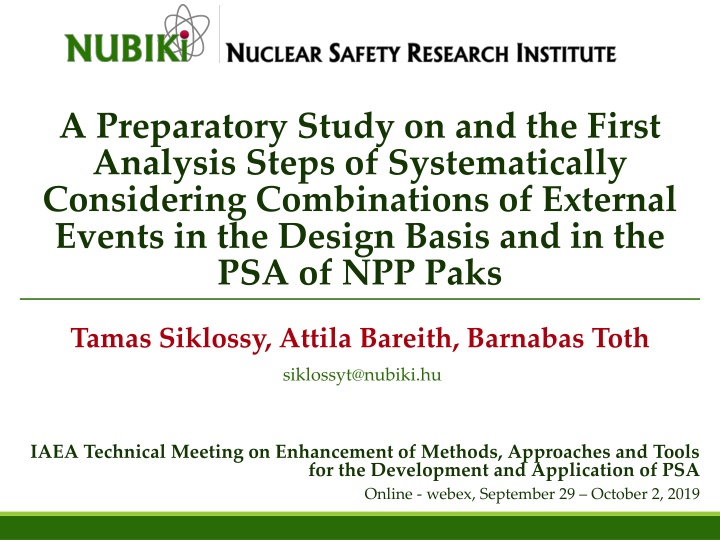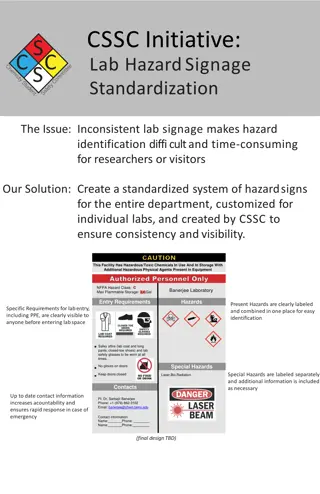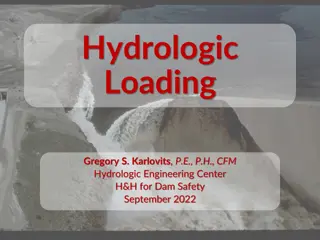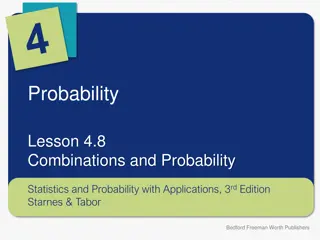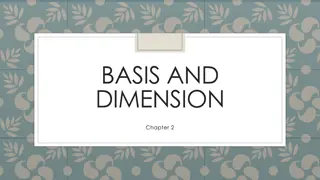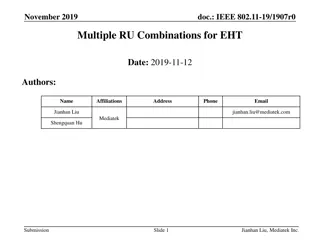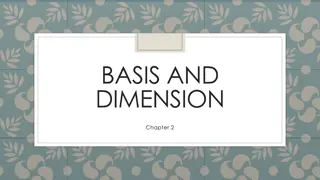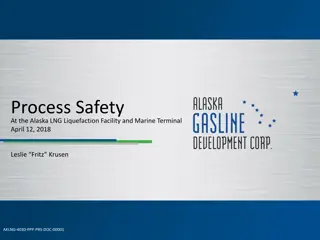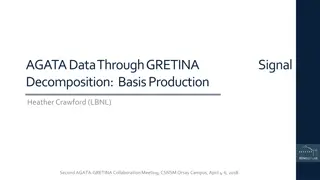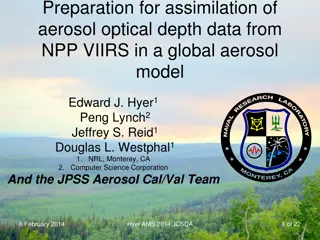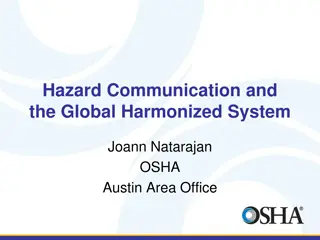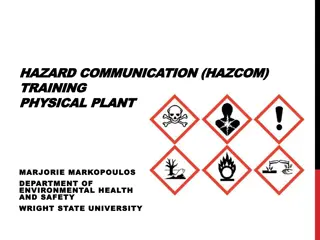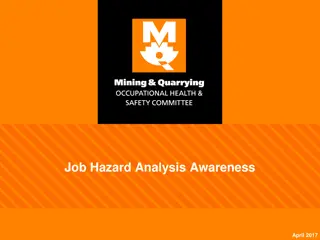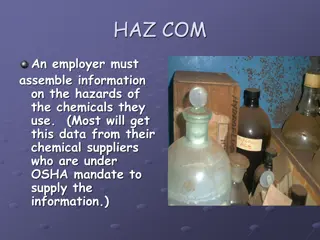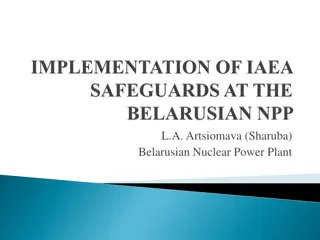Enhancing Safety through Systematic Hazard Combinations Analysis in NPP Design Basis & PSA at NPP Paks
In this preparatory study, Tamas Siklossy, Attila Bareith, and Barnabas Toth discuss the importance of considering hazard combinations in the design basis and PSA of the Paks NPP in Hungary. The study reviews current practices, outlines technical tasks, and emphasizes the need to assess the impact of external hazard combinations on NPP safety. Lessons from past accidents like Fukushima Dai-ichi are studied to drive improvements in safety protocols. The work aims to identify, characterize, and quantify the effects of hazard combinations to justify protection measures and quantify residual risks. The research engages with international and national R&D programs to enhance safety measures according to regulatory frameworks. The study culminates with proposed technical tasks and a schedule for systematic hazard analysis.
Download Presentation

Please find below an Image/Link to download the presentation.
The content on the website is provided AS IS for your information and personal use only. It may not be sold, licensed, or shared on other websites without obtaining consent from the author.If you encounter any issues during the download, it is possible that the publisher has removed the file from their server.
You are allowed to download the files provided on this website for personal or commercial use, subject to the condition that they are used lawfully. All files are the property of their respective owners.
The content on the website is provided AS IS for your information and personal use only. It may not be sold, licensed, or shared on other websites without obtaining consent from the author.
E N D
Presentation Transcript
A Preparatory Study on and the First Analysis Steps of Systematically Considering Combinations of External Events in the Design Basis and in the PSA of NPP Paks Tamas Siklossy, Attila Bareith, Barnabas Toth siklossyt@nubiki.hu IAEA Technical Meeting on Enhancement of Methods, Approaches and Tools for the Development and Application of PSA Online - webex, September 29 October 2, 2019
Content Introduction Overview of the publically available literature A critical review of current Hungarian practices Proposed technical tasks in details considering hazard combinations in the design basis and PSA Achievements in selection and screening of external hazard combinations Conclusions 9/13/2024 Systematically Considering Combinations of External Events in the Design Basis and the PSA 2
Introduction Mostly single external hazards have been considered in the definition of the design basis for the Paks NPP in Hungary Motivation of assessing the impact of hazard combinations on NPP safety Requirements laid down in Hungarian Nuclear Safety Codes and international recommendations Lessons learnt from the Fukusima Dai-ichi accident International/national R&D programs According to a corrective measure of the PSR of the Paks NPP in 2017: a systematic survey and assessment should be performed to: identify and characterize external hazard combinations assess the effects of hazard combinations on NPP safety: the adequacy of protection against hazard combinations to be included in the design basis has to be justified the residual risk due to beyond design basis load combinations has to be quantified The technical tasks and the schedule thereof had to be worked out first. 9/13/2024 Systematically Considering Combinations of External Events in the Design Basis and the PSA 3
Overview of the Publically Available Literature Hungarian regulations: NSC International recommendations: WENRA and IAEA Swedish Nuclear Inspectorate: SKI Report 02:27 (2003) EPRI: Identification of External Hazards for Analysis in Probabilistic Risk Assessment (Update 2015) Technical reports developed in the ASAMPSA_E project A WGRISK task and the corresponding questionnaire on external hazards PSA (2007) Technical articles on national assessments, e.g.: GRS on screening of hazard combinations External hazard combinations PSA for NPP Hanhikivi Methodological documents on multivariate distribution functions 9/13/2024 Systematically Considering Combinations of External Events in the Design Basis and the PSA 4
A Critical Review of Current Hungarian Practices Design Basis 1. FSAR targeted assessment in 2002: no need to consider any hazard combinations in the design basis not a state-of-the-art analysis (simplistic, have not been updated) 2. Assessments of single hazards included considerations to some potential hazard combinations man-made hazards no correlation, except for meteorological conditions meteorology no correlation, except for wind&snow loads on structures Danube contamination endangering the water intake system combination considered in the identification of relevant event sequences hydrology possible combinations of single hydrological events geosciences all seismological hazards are assessed in conjunction with geotechnical, geological and tectonic conditions and hazards The combination among the different types of hazards was not assessed 3. Site investigation and evaluation program for new NPP builds (Paks 2016-2018) targeted assessment of hazard combinations the results cannot be applied directly to the existing NPP units without further investigations the assessment has some inherent boundaries that should be considerd, e.g. no input data derived for PSA need to revise and supplement quite a few analysis assumptions and evaluations 9/13/2024 Systematically Considering Combinations of External Events in the Design Basis and the PSA 5
A Critical Review of Current Hungarian Practices PSA No dedicated PSA for hazard combinations for the Paks NPP PSA for single hazards includes considerations to some potential hazard combinations full correlation for instantaneous, daily average and weekly average air temperature and cooling water temperature hydraulic load assessment for the canalization system extreme precipitation & LOOP (cooling water of diesel generators) potential snow induced blockage of air intake systems (wind&snow) fragility of the grid due to extreme temperature (all relevant grid related events that may occur) vulnerability of the power transmission lines to the combination of extreme wind, frost and ice formation, and high/low air temperatures partial correlation between earthquake and soil liquefaction 9/13/2024 Systematically Considering Combinations of External Events in the Design Basis and the PSA 6
Types of External Hazard Combinations Combination of dependent hazards causal connection Consequential hazards cause-effect relation: A may cause B (e.g. explosion forest fire) A is a prerequisite of B (e.g. earthquake soil liquefaction) Non-consequential connected hazards (correlated hazards) common root cause (e.g. certain meteorological conditions trigger many hazardous phenomena) Combination of independent hazards no causal connection independent events have a high occurrence frequency, at least one of the events is long-lasting and usually rare. 9/13/2024 Systematically Considering Combinations of External Events in the Design Basis and the PSA 7
Proposed Technical Tasks PSA: I. II. III. Detailed assessment of screened-in events: i. Probabilistic hazard assessment ii. Plant response and fragility analysis iii. Event logic modeling and risk quantification Selection of external hazard combinations Screening of external hazard combinations Design basis (identification of hazard combinations and justification of plant protection): I. Selection of external hazard combinations II. Screening of external hazard combinations III. Definition of design basis load combinations IV. Evaluation of plant protection and specification of protective measures 9/13/2024 Systematically Considering Combinations of External Events in the Design Basis and the PSA 8
Selection of External Hazard Combinations Development of a comprehensive list of potential single external hazards Screening of single hazards with respect to hazard combinations screening by relevance (cannot occur at the site) frequency based screening (Hungary: 10-7/a for an existing NPP) Evaluation of the dependence among the hazards a table ( matrix ) form cross-correlation chart for all the possible hazard combinations, the possible relation type has to be identified and marked with a predefined symbol identification of hazard combinations including 3 or more hazards: mapping of root causes that may trigger such combinations studying the dependence in rows and columns of the cross-corr. chart 9/13/2024 Systematically Considering Combinations of External Events in the Design Basis and the PSA 9
9/13/2024 Systematically Considering Combinations of External Events in the Design Basis and the PSA 10
Selection of External Hazard Combinations Possible relation types one hazard is a prerequisite of the other hazard one hazard may cause the other hazard, the impact mechanisms of the single hazards are similar or the same one hazard may cause the other hazard, the impact mechanisms of the single hazards are different correlated hazards, the impact mechanisms of the single hazards are similar or the same correlated hazards, the impact mechanisms of the single hazards are different independent hazards, the impact mechanisms of the single hazards are similar or the same independent hazards, the impact mechanisms of the single hazards are different mutually exclusive hazards 9/13/2024 Systematically Considering Combinations of External Events in the Design Basis and the PSA 11
Screening of External Hazard Combinations In general, the same screening criteria as for single hazards Relation between the impact mechanisms of the single hazards: similar or the same (e.g. wind & snow to structures): hazards affect the same SSCs amplifying one another s effects resistance against the combined load has to be assessed different (e.g. wind & high temperature) hazards do not affect the same SSCs or not with the same mechanisms Hazard combinations specific screening criteria: hazards are mutually exclusive definition of a single hazard incorporates the other single hazard the impact of the hazard combination is not more severe than the effect of the more powerful hazard 9/13/2024 Systematically Considering Combinations of External Events in the Design Basis and the PSA 12
Screened-in Combinations of External Hazards storm: high wind and extreme precipitation and thunder snowstorm: high wind and extreme snow extremely high temperature conditions: extremely high air temperature and high Danube water temperature extremely low temperature conditions: extremely low air temperature and surface ice on the Danube (and icing and snow) earthquake and soil liquefaction earthquake and extremely high or low air temperature (independent) simultaneous accident in nearby industrial facilities that handle dangerous chemical substances (due to a common root cause) extreme meteorological conditions and handling of dangerous substances (the meteorological conditions may have a significant impact on the dispersion of dangerous substances) 9/13/2024 Systematically Considering Combinations of External Events in the Design Basis and the PSA 13
Probabilistic Hazard Assessment Frequency-magnitude relationship for different magnitudes of load combinations combination of dependent hazards causal connection consequential hazards cause-effect relation ?1,2= ?1 ?(2 1) correlated hazards common root cause correlation has to be determined hazard curve (surface) development, e.g. multivariate extreme value theory for meteorological hazards current practice: hazard occurrence frequencies for predefined combinations of load intensity combination of independent hazards (high occurrence freq. or long-lasting event) 0 ? = ? ?1 ?2 ?1+ ?2 ??occurrence frequency of event i [1/a] ??duration of event i [year] N duration (within a year) when both events can occur simultaneously [year] ??2(?) ? ?+?2?1(?)???? + 0 ??1(?) ? ?+?1?2(?)???? = ? 9/13/2024 Systematically Considering Combinations of External Events in the Design Basis and the PSA 14
Plant Response and Fragility Analysis, Event Logic Modeling, Risk Quantification Plant response and fragility analysis which SSCs are challenged and how to characterize the vulnerability ideally: probability of failure for different levels of load combinations by means of fragility surfaces current practice: fragility for predefined combinations of load intensity relation between the impact mechanisms of the single hazards is decisive Event logic modeling and risk quantification approach is similar to that of the single hazards PSA assessment of plant transients, degradation of mitigation systems induced by hazard combination, impact on the conditions of human interactions/responses random SSC failures and human failure events considered too 9/13/2024 Systematically Considering Combinations of External Events in the Design Basis and the PSA 15
Conclusions As a preparatory step to systematically identify and assess the combinations of external hazards for the Paks NPP: the regulations and recommendations have been thorougly reviewed the available methodologies have been studied and evaluated analysis practices applied in Hungary have been examined a proposal has been developed for the technical tasks and the schedule thereof to identify combinations of external hazards and assess the effects of such hazards on NPP safety The assessment of external hazard combinations has been started in 2019 and is planned to be finished in 2022. Selection and screening of external hazard combinations performed 9/13/2024 Systematically Considering Combinations of External Events in the Design Basis and the PSA 16
Thank you for your attention!
